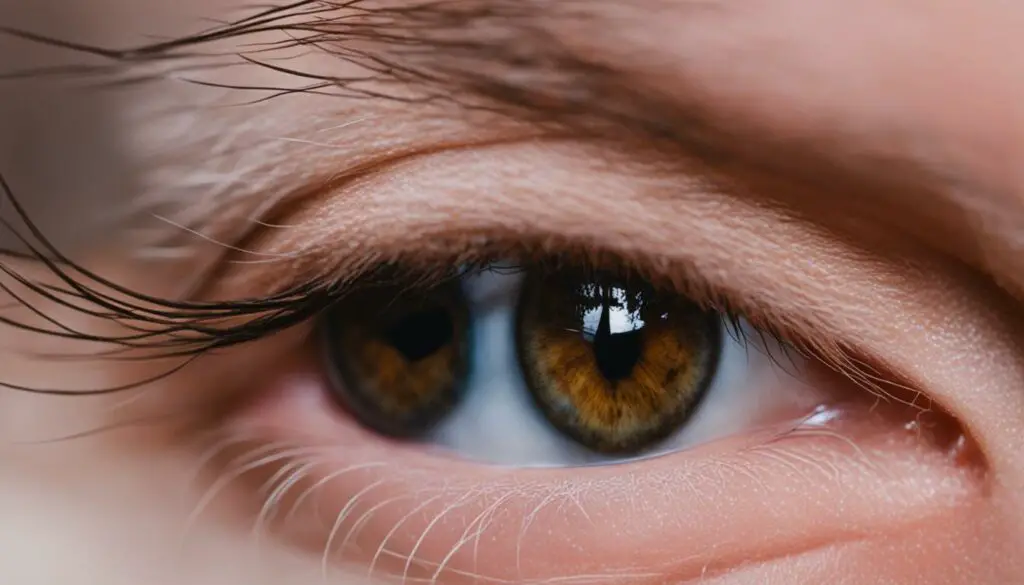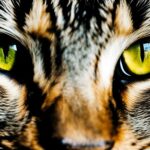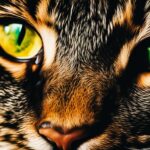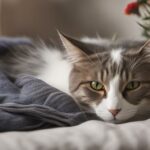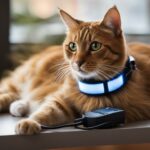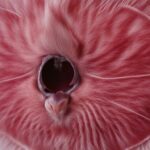Entropion is an abnormal inward rolling of the eyelids in cats, causing irritation and pain. It can affect both upper and lower lids, but lower eyelid entropion is most common. Short-nosed breeds, such as Himalayan and Persian cats, have a higher likelihood of developing entropion. Symptoms can include squinting, eye discharge, rubbing the eye, swollen eyelids, and redness. Entropion can be congenital, developmental, or acquired, and the cause can vary. It is important to diagnose entropion in cats, as it can lead to corneal ulcers and other complications. Veterinarians use various tests to determine the presence of entropion and may recommend surgical correction for severe cases.
Key Takeaways:
- Entropion is an abnormal inward rolling of the eyelids in cats.
- Symptoms of entropion in cats include squinting, eye discharge, and swollen eyelids.
- Short-nosed breeds are more prone to developing entropion.
- Veterinarians can diagnose entropion through various tests and may recommend surgery for severe cases.
- Early diagnosis and treatment are crucial to prevent complications and maintain eye health in cats.
Signs and Symptoms of Entropion in Cats
When it comes to entropion in cats, recognizing the signs and symptoms is crucial for early intervention and treatment. Cats with this condition may exhibit a range of visual and behavioral changes indicative of eye discomfort. Some common signs to watch out for include:
- Squinting
- Eye discharge
- Eye rubbing
- Nasal discharge
- Swollen eyelids
- Red eyes
- Eyelid spasms
- Raised third eyelid
- Conjunctivitis
- Cloudy cornea
- Ulceration
These symptoms can vary in severity depending on the stage and extent of the entropion. If you notice any of these signs in your cat, it’s important to seek veterinary attention promptly for a comprehensive eye examination and accurate diagnosis.
To visually illustrate the signs and symptoms of entropion in cats, refer to the table below:
| Signs and Symptoms | Description |
|---|---|
| Squinting | A narrowed appearance of the affected eye |
| Eye discharge | Excessive tearing or discharge from the eye |
| Eye rubbing | Frequent rubbing or pawing at the eye |
| Nasal discharge | Clear or colored discharge from the nose |
| Swollen eyelids | Puffy or swollen appearance of the eyelids |
| Red eyes | The whites of the eyes may appear reddened |
| Eyelid spasms | Involuntary twitching or spasms of the eyelids |
| Raised third eyelid | Visible protrusion of the inner eyelid |
| Conjunctivitis | Inflammation of the conjunctiva, causing redness and irritation |
| Cloudy cornea | Hazy or opaque appearance of the cornea |
| Ulceration | Open sores or ulcers on the cornea |
By familiarizing yourself with these signs and symptoms, you can play an active role in safeguarding your cat’s eye health and well-being.
Causes of Entropion in Cats
Entropion in cats can have various causes that contribute to the abnormal inward rolling of the eyelids. Understanding these causes is crucial for accurately diagnosing and treating the condition. There are three main causes of entropion in cats: congenital, anatomical or developmental, and acquired.
Congenital Entropion
Congenital entropion is present at birth and is most commonly seen in young kittens. It occurs when the eyelids develop abnormally, causing them to roll inward. Certain breeds, such as the Himalayan and Persian, are more prone to congenital entropion. Early detection and intervention are essential to prevent complications and ensure the well-being of affected kittens.
Anatomical or Developmental Entropion
Anatomical or developmental entropion is rare and is often seen in brachycephalic breeds and cats with specific connective tissue conditions. Brachycephalic cats, such as Persians and British Shorthairs, have a shorter snout, which can contribute to eyelid abnormalities. Additionally, certain connective tissue disorders can affect the stability and position of the eyelids, leading to entropion.
Acquired Entropion
Acquired entropion can be further classified into spastic, cicatricial, and involutional entropion. Spastic entropion occurs as a secondary effect of another ocular disease, such as conjunctivitis or corneal ulcers. Cicatricial entropion is caused by eyelid damage or swelling, which alters the position of the eyelids. Involutional entropion is most commonly seen in senior cats and involves the loss of fat behind the eye, leading to eyelid malposition.
Identifying the specific cause of entropion in cats is essential for determining the most appropriate treatment plan. Veterinarians use various diagnostic tests and examinations to assess the underlying cause and severity of the condition, ensuring effective and targeted treatment.
How Veterinarians Diagnose Entropion in Cats
Diagnosing entropion in cats requires a comprehensive eye examination performed by a veterinarian. During the examination, the veterinarian will observe the position of the eyelids and may use topical anesthetics to numb the eye for a better evaluation. They will also assess the overall eye health and look for any signs of corneal ulcers or other complications.
In addition to the physical examination, veterinarians may perform several tests to confirm the presence of entropion and determine its severity and underlying cause. These tests may include a fluorescein stain test, which involves applying a dye to the eye to detect any corneal ulcers or abrasions. The intraocular pressure test measures the pressure inside the eye, while the Schirmer tear test evaluates tear production.
By combining the findings from the examination and the test results, veterinarians can make an accurate diagnosis of entropion in cats. This diagnosis is crucial for determining the appropriate treatment plan, whether it be medication, surgical correction, or alternative treatment options.
| Diagnostic Tests for Entropion in Cats | Procedure |
|---|---|
| Comprehensive Eye Examination | Observation of eyelid position, overall eye health assessment |
| Fluorescein Stain Test | Application of dye to detect corneal ulcers or abrasions |
| Intraocular Pressure Test | Measurement of pressure inside the eye |
| Schirmer Tear Test | Evaluation of tear production |
These diagnostic tests, along with the veterinarian’s expertise, allow for a thorough evaluation and accurate diagnosis of entropion in cats. It is essential to seek veterinary attention if you suspect your cat may be suffering from entropion to ensure proper treatment and prevent potential complications.
Treatment Options for Entropion in Cats
When it comes to treating entropion in cats, the approach depends on the cause and severity of the condition. In cases of spastic entropion, the first step is to identify and treat the underlying ocular disease. This may involve the use of antibiotics, pain relievers, and antivirals to manage any related symptoms. By addressing the root cause of the entropion, veterinarians can help alleviate the discomfort and improve the cat’s overall eye health.
For more severe cases of entropion, surgical correction is often necessary. The most common surgical procedure used is the Hotz-Celsus technique. It involves removing a portion of the eyelid and repositioning it to correct the inward rolling. This procedure not only helps relieve the irritation and pain associated with entropion but also prevents further complications such as corneal ulcers.
In some instances, especially with older cats who may not tolerate anesthesia well, hyaluronic acid injections can be used as an alternative to surgery. These injections help to tighten the tissues around the eye, reducing the inward rolling of the eyelids. While not suitable for all cases, hyaluronic acid injections offer a less invasive option for managing entropion in certain situations.
| Treatment Options | Description |
|---|---|
| Surgical Correction | The Hotz-Celsus technique involves removing a portion of the eyelid and repositioning it to correct the entropion. This procedure is effective in severe cases. |
| Hyaluronic Acid Injections | Injections of hyaluronic acid can be used as an alternative to surgery, particularly in older cats who may not tolerate anesthesia well. These injections help tighten the tissues around the eye, reducing the inward rolling of the eyelids. |
| Medications | If the entropion is spastic and caused by an underlying ocular disease, medications such as antibiotics, pain relievers, and antivirals may be prescribed to manage symptoms and promote healing. |
It’s important to consult with a veterinarian to determine the best course of treatment for your cat’s entropion. They will consider factors such as the cat’s overall health, the severity of the condition, and any underlying causes before recommending the most suitable treatment option. Remember, early intervention and proper treatment are key to ensuring your cat’s eye health and overall well-being.
Recovery and Follow-Up Care for Entropion Surgery in Cats
After your cat undergoes entropion surgery, it is important to provide them with proper care during the recovery period. This will help ensure a successful healing process and minimize the risk of complications. Here are some guidelines to follow:
Post-Surgery Care:
- Protective Collar: Your cat may need to wear an Elizabethan collar to prevent them from scratching or rubbing their eyes. This will allow the surgical site to heal undisturbed.
- Medications: Your veterinarian may prescribe topical eye medications and oral medications to manage pain, inflammation, and prevent infection. It is crucial to administer these medications as instructed.
- Monitor for Complications: Keep a close eye on your cat’s recovery progress and watch for any signs of complications, such as pus-like discharge, increased redness or swelling, worsening squinting, cloudiness of the eye, or decreased appetite. If you notice any of these symptoms, contact your veterinarian immediately.
Follow-Up Appointments:
Regular follow-up appointments with your veterinarian are essential to monitor the healing process and ensure optimal recovery. These appointments may include:
- Suture Removal: If your cat’s surgery involved the use of sutures, your veterinarian will schedule a visit to remove them. This is typically done around 7-10 days after the surgery.
- Ocular Examination: Your veterinarian will examine your cat’s eyes to ensure that the surgery was successful and to check for any signs of complications. They may perform additional tests, such as a fluorescein stain test, to assess corneal health.
During these follow-up appointments, it is important to communicate any concerns or changes you have noticed in your cat’s behavior or eye health. Your veterinarian can provide guidance and make any necessary adjustments to the post-operative care plan.
Table: Post-Surgery Care Guidelines
| Post-Surgery Care Guidelines |
|---|
| Ensure your cat wears an Elizabethan collar to prevent self-trauma. |
| Administer prescribed topical eye medications and oral medications as instructed. |
| Monitor for signs of complications, such as discharge, redness, swelling, squinting, cloudiness, or decreased appetite. |
| Schedule follow-up appointments for suture removal and ocular examination. |
| Communicate any concerns or changes in your cat’s health during follow-up appointments. |
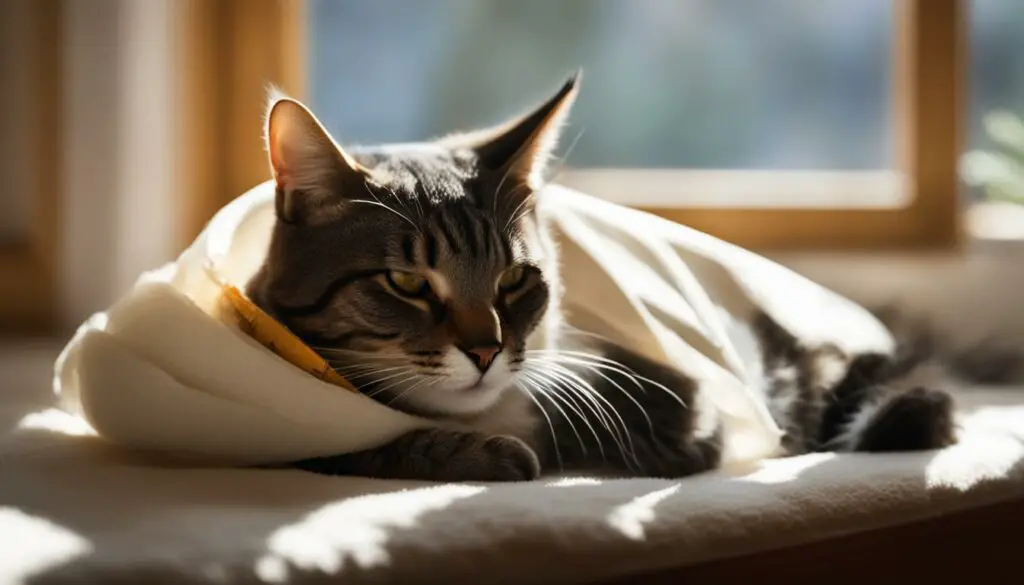
Cost of Entropion Surgery for Cats
When it comes to the cost of entropion surgery for cats, factors such as location, veterinarian experience, and the complexity of the surgery can influence the final price. On average, entropion surgery may cost less than $1,000. However, more complicated cases or surgeries performed by veterinary ophthalmologists may incur several times that amount.
It’s important to keep in mind that the cost of the surgery is an investment in your cat’s well-being. Entropion can cause irritation, pain, and potential complications, and surgical correction is often necessary for severe cases. By addressing entropion through surgery, you can help improve your cat’s quality of life and prevent further eye-related complications.
If you’re concerned about the cost, it’s worth discussing potential financing options or payment plans with your veterinarian. They may be able to provide alternative solutions to help make the surgery more affordable or offer recommendations for organizations that assist with veterinary expenses. Remember, the long-term benefits of addressing entropion in your cat outweigh the initial cost of the surgery.
| Treatment Options | Average Cost |
|---|---|
| Entropion Surgery (less complicated cases) | $500 – $1,000 |
| Entropion Surgery (more complicated cases) | $1,000+ |
| Hyaluronic Acid Injections (alternative to surgery) | $200 – $500 per treatment |
Remember, these figures are estimates and can vary depending on various factors. It’s always best to consult with your veterinarian for an accurate cost assessment based on your cat’s specific needs.
Alternative Treatment Options for Entropion in Cats
While surgical correction is the most common treatment for entropion in cats, there are alternative options available that can help manage and prevent this condition. These alternative treatments can provide temporary relief and may be suitable for cats who are not ideal candidates for surgery or require immediate intervention. Here are some alternative treatment options for entropion in cats:
- Temporary tacking procedures: These procedures involve using sutures or surgical staples to temporarily reposition the eyelids and provide relief from the inward rolling. This is often done as a temporary measure until permanent corrective surgery can be performed.
- Regular eye examinations: Routine eye exams allow veterinarians to monitor the cat’s eye health and detect any early signs of entropion. Early intervention can help prevent the condition from worsening or developing in the first place.
- Prompt treatment of underlying ocular diseases: Some cases of entropion are secondary to other eye conditions. Treating and managing these underlying diseases can help prevent the progression of entropion.
It is important to note that while these alternative treatment options may provide temporary relief or prevent further complications, surgical correction is often necessary for severe cases of entropion. Consulting with a veterinarian is crucial to determine the most appropriate course of action for your cat.
Alternative Treatment Options for Entropion in Cats
In addition to surgical correction and hyaluronic acid injections, there are alternative treatment options that can help manage and prevent entropion in cats. Temporary tacking procedures, using sutures or surgical staples, may be used to provide temporary relief until permanent corrective surgery can be performed. Regular eye examinations and prompt treatment of any underlying ocular diseases can also help prevent the development of entropion in cats.
| Treatment Option | Description |
|---|---|
| Temporary tacking procedures | Using sutures or surgical staples to temporarily reposition the eyelids and provide relief from the inward rolling. This is often done as a temporary measure until permanent corrective surgery can be performed. |
| Regular eye examinations | Routine eye exams allow veterinarians to monitor the cat’s eye health and detect any early signs of entropion. Early intervention can help prevent the condition from worsening or developing in the first place. |
| Prompt treatment of underlying ocular diseases | Some cases of entropion are secondary to other eye conditions. Treating and managing these underlying diseases can help prevent the progression of entropion. |
It is important to note that while these alternative treatment options may provide temporary relief or prevent further complications, surgical correction is often necessary for severe cases of entropion. Consulting with a veterinarian is crucial to determine the most appropriate course of action for your cat.
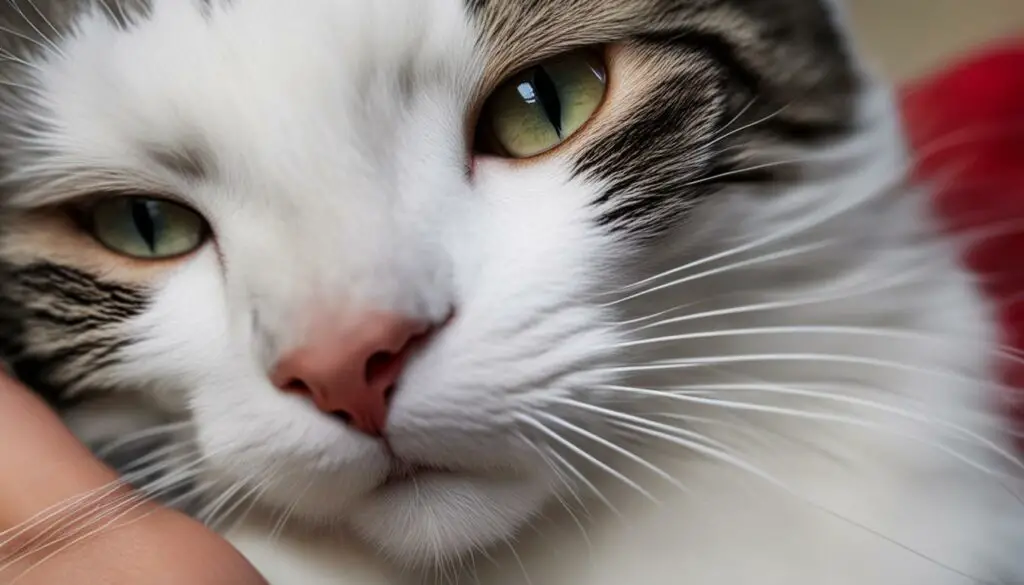
Long-Term Management of Entropion in Cats
After surgical correction of entropion in cats, it is crucial to ensure long-term management to maintain optimal eye health. While most cats recover successfully from surgery, some may require ongoing care due to permanent corneal scarring or conjunctivitis. This involves regular monitoring and the use of appropriate medications to alleviate discomfort and prevent dryness.
One effective long-term management option is the use of lubricating eye gels, such as Optixcare. These gels provide soothing relief to the eyes and help prevent dryness, particularly in brachycephalic breeds that may be prone to entropion recurrence. Regular application of these gels can significantly improve a cat’s eye comfort and overall well-being.
Additionally, ongoing monitoring of the cat’s eye health is essential. Regular check-ups with a veterinarian will ensure early detection of any complications or changes in the condition. Prompt intervention and treatment can help maintain the best chance of success and restore the eye to normal function.
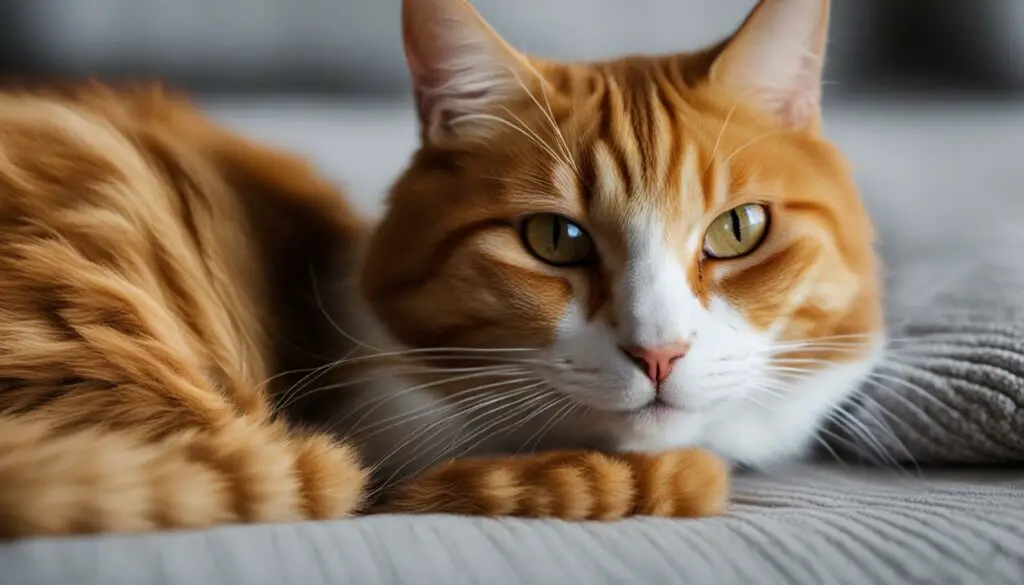
Table: Comparison of Long-Term Management Options for Entropion in Cats
| Management Option | Description |
|---|---|
| Lubricating Eye Gels | These gels provide soothing relief and prevent dryness in the eyes. |
| Regular Monitoring | Ongoing check-ups with a veterinarian to detect any changes or complications early. |
By implementing these long-term management strategies, cat owners can ensure their furry companions maintain optimal eye health and minimize the risk of entropion-related complications in the future.
Conclusion
Entropion is a common eye condition in cats, particularly in brachycephalic breeds and Persians. It can cause irritation, pain, and potential complications such as corneal ulcers. Diagnosing entropion involves a thorough eye examination, and treatment options range from medications to surgical correction. Recovery from entropion surgery is generally successful, but long-term management may be required in some cases. Regular monitoring and prompt veterinary care are essential for maintaining eye health in cats.
If you suspect your cat may have entropion, it’s important to seek veterinary attention. A comprehensive eye examination can determine the severity and underlying cause of the condition, allowing for appropriate treatment. Depending on the individual case, medication or surgical correction may be recommended.
While surgical correction is often necessary for severe cases, it’s important to note that recovery from entropion surgery is generally successful. However, some cats may require long-term management to maintain eye comfort and health. Regular check-ups and monitoring of the cat’s eye health can help ensure the best outcomes and minimize the risk of complications.
Remember, early intervention and regular veterinary care are key to preserving your cat’s eye health. By staying vigilant and seeking timely treatment, you can help your furry friend lead a comfortable and happy life, free from the symptoms and complications of entropion.
FAQ
What are the signs and symptoms of entropion in cats?
Cats with entropion may display symptoms such as squinting, eye discharge, rubbing the eye, nasal discharge, swollen eyelids, red eyes, eyelid spasms, raised third eyelid, conjunctivitis, cloudy cornea, and ulceration. These signs can vary depending on the severity of the entropion. It is important to monitor your cat closely for any changes in their eye health and seek veterinary attention if you notice any of these symptoms.
What are the causes of entropion in cats?
There are three main causes of entropion in cats. Congenital entropion is present at birth and is most commonly seen in young kittens. Anatomical or developmental entropion is rare and is often seen in brachycephalic breeds or cats with a special connective tissue condition. Acquired entropion can be spastic, cicatricial, or involutional. Spastic entropion occurs as a secondary effect of another ocular disease, while cicatricial entropion is caused by eyelid damage or swelling. Involutional entropion is most often seen in senior cats and involves the loss of fat behind the eye.
How do veterinarians diagnose entropion in cats?
Veterinarians can diagnose entropion in cats by performing a comprehensive eye examination. They may use topical anesthetics to numb the eye and observe the eyelid position. Other tests, such as a fluorescein stain test, intraocular pressure test, and Schirmer tear test, may be used to assess corneal health and tear production. These tests help determine the severity and underlying cause of the entropion.
What are the treatment options for entropion in cats?
The treatment for entropion in cats depends on the cause and severity of the condition. In cases of spastic entropion, the underlying ocular disease must be identified and treated. Medications such as antibiotics, pain relievers, and antivirals may be prescribed to manage any related symptoms. Surgical correction is often necessary for severe entropion. The most common surgical procedure is the Hotz-Celsus technique, which involves removing a portion of the eyelid and repositioning it to correct the inversion. In some cases, hyaluronic acid injections may be used as an alternative to surgery, especially in older cats who may not tolerate anesthesia well.
What is the recovery and follow-up care for entropion surgery in cats?
After entropion surgery, cats will require a period of recovery and post-operative care. This may include wearing an Elizabethan collar to prevent self-trauma to the eyes or incisions. Topical eye medications and oral medications may be prescribed to manage pain, inflammation, and prevent infection. Follow-up appointments are necessary to monitor the healing process and remove any sutures. It is important to contact a veterinarian if your cat shows any signs of complications, such as pus-like discharge, increased redness or swelling, worsening squinting, cloudiness of the eye, or decreased appetite.
How much does entropion surgery for cats cost?
The cost of entropion surgery for cats can vary depending on the veterinarian’s location, experience level, and the complexity of the surgery. On average, entropion surgery may cost less than $1,000, but more complicated cases or surgeries performed by veterinary ophthalmologists may cost several times that amount.
Are there alternative treatment options for entropion in cats?
In addition to surgical correction and hyaluronic acid injections, there are alternative treatment options that can help manage and prevent entropion in cats. Temporary tacking procedures, using sutures or surgical staples, may be used to provide temporary relief until permanent corrective surgery can be performed. Regular eye examinations and prompt treatment of any underlying ocular diseases can also help prevent the development of entropion in cats.
What is the long-term management of entropion in cats?
Some cats may require long-term management for entropion, even after surgical correction. Permanent corneal scarring and conjunctivitis can occur in some cases and may require ongoing medication to maintain eye comfort and health. Lubricating eye gels, such as Optixcare, can help soothe the eye and prevent dryness. Brachycephalic breeds may benefit from continued lubrication to decrease the risk of entropion recurrence. Regular monitoring of the cat’s eye health and early intervention can help ensure the best chance of success and return the eye to normal function.

